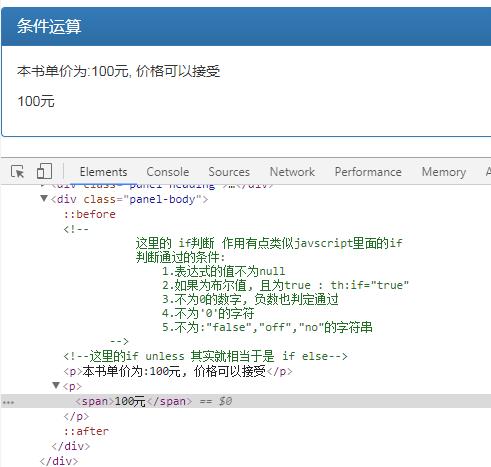spring boot 与 thymeleaf : 设置属性条件遍历局部变量优先级内联语法
Posted Sniper_ZL
tags:
篇首语:本文由小常识网(cha138.com)小编为大家整理,主要介绍了spring boot 与 thymeleaf : 设置属性条件遍历局部变量优先级内联语法相关的知识,希望对你有一定的参考价值。
前面记录了 thymeleaf 基本表达式, 这里继续看一下其他功能.
一. 设置属性值
这里的controller, html框架 还是沿用上一篇的部分.
html:
<div class="panel panel-primary"> <div class="panel-heading"> <h3 class="panel-title">设置属性值</h3> </div> <div class="panel-body"> <!--从自定义属性这里看, html所有的属性, 都可以通过 th:属性名=的方式来写--> <p th:elvin="${book.name}">1.自定义属性 th : elvin</p> <!--attr设置属性 attr可以设置任何属性值, 但是一般不会用它设置所有属性值--> <p th:attr="elvin=${book.name},title=${book.name}">2.attr设置属性值</p> <!--一般html原来的属性, 通过 th : 属性名 的方式来使用 设置多个属性: th : alt-title, th : lang-xmllang --> <p th:title="${book1.name}">3.html原来的属性</p> <!--对于checked, disabled 这种的, 其判断值的方式和 if 的方式一致, 具体在if中详述 --> <input type="checkbox" th:checked="${book.price % 2 == 0}" th:disabled="${book.price % 2 == 0}" />a <input type="checkbox" th:checked="1" th:disabled="${book.price % 2 gt 0}" />b <input type="checkbox" th:checked="no" />c <!--classappend:可以添加class,而不会删除之前的class styleappend:可以添加样式,不会删除之前的样式,但是效果上会覆盖之前的样式--> <p class="pc" th:classappend="cp" style="border: 1px solid blue;background-color:red;" th:styleappend="\'background-color:#82af86;\'">4.追加class和style</p> <!--attrappend:在原有基础的后面添加属性值 attrprepend:在原有的基础的前面插入属性值--> <p title="原来的title" th:attrappend="title=\' 添加的title\'" th:attrprepend="title=\'最前面的title \'">5.前置,后置添加属性值</p> <!--虽然这里提供了事件设置的方式, 但是个人建议, 将事件绑定分离出去--> <p th:onclick="|console.log(\'${book.publishTime}\')|">6.设置事件属性</p> </div> </div>
结果展示:

二. 条件运算
<div class="panel panel-primary"> <div class="panel-heading"> <h3 class="panel-title">条件运算</h3> </div> <div class="panel-body"> <!-- 这里的 if判断 作用有点类似javscript里面的if 判断通过的条件: 1.表达式的值不为null 2.如果为布尔值, 且为true : th:if="true" 3.不为0的数字, 负数也判定通过 4.不为\'0\'的字符 5.不为:"false","off","no"的字符串 --> <!--这里的if unless 其实就相当于是 if else--> <p th:if="${book.price > 10000}" th:text="|本书单价为:${book.price / 100}元, 有点小贵|"></p> <p th:unless="${book.price > 10000}" th:text="|本书单价为:${book.price / 100}元, 价格可以接受|"></p> <p th:switch="${book.price}"> <span th:case="100" th:text="1块钱"></span> <span th:case="${book.price}" th:text="${book.price / 100} + \'元\'"></span> <span th:case="*" th:text="居然都不是, 只能选这个了"></span> </p> </div> </div>
if 和 unless 是相反的, 所以如果只有一个 if , unless确实可以当成是if对应的else来使用. 当然, 如果是 if - else if - else if - else也是可以实现的, 但是要嵌套进去, 不方便阅读. 就不写了.
switch里面, case="*" 相当于java里面的default, 只要有一个满足条件, 别的都不会再显示和判断了.
结果展示:

三. 遍历
数据准备: 在原来controller的方法下面继续添加
List<Book> bookList = new ArrayList<>(); bookList.add(book); bookList.add(book1); bookList.add(new Book("bootstrap", new DateTime().toString("yyyy-MM-dd"), 11000L)); bookList.add(new Book("javascript", new DateTime().toString("yyyy-MM-dd"), 1020L)); model.addAttribute("bookList", bookList); Map<String, Book> map = new HashMap<>(); String pre = "index_"; for (int i = 0; i < bookList.size(); i++) { map.put(pre + i, bookList.get(i)); } model.addAttribute("bookMap", map);
html:
<div class="panel panel-primary"> <div class="panel-heading"> <h3 class="panel-title">列表List</h3> </div> <div class="panel-body"> <ul class="list-group"> <!--循环方法 这里的item,自命名的,就相当于 bookList.get(index) iterInfo,自命名的, 是单条数据的补充信息, 比如里面有 索引。 each可以迭代的对象: 1. 任何实现java.util.Iterable接口的对象 2. 任何实现java.util.Enumeration接口的对象 3. 任何实现java.util.Iterator接口的对象, 其值将被迭代器返回,而不需要再内存中缓存所有值 4. 任何实现java.util.Map的接口对象. 迭代时, iter变量将是 Entry类 5. 任何数组 6. 任何其将被视为包含对象本身的单值列表 --> <li class="list-group-item" th:each="item,iterInfo:${bookList}"> <span th:text="\'index:\' + ${iterInfo.index}"></span> <span th:text="\'size:\' + ${iterInfo.size}" style="margin-left:10px;"></span> <span th:text="\'count:\' + ${iterInfo.count}" style="margin-left:10px;"></span> <span th:text="\'odd:\' + ${iterInfo.odd}" style="margin-left:10px;"></span> <span th:text="\'even:\' + ${iterInfo.even}" style="margin-left:10px;"></span> <span th:text="\'first item:\' + ${iterInfo.first}" style="margin-left:10px;"></span> <span th:text="\'last item:\' + ${iterInfo.last}" style="margin-left:10px;"></span> <span th:text="${item.name}" style="margin-left:10px;"></span> <span th:text="${item.price} + \'分\'" style="margin-left:10px;"></span> <span th:text="${item.publishTime}" style="margin-left:10px;"></span> </li> </ul> </div> </div> <div class="panel panel-primary"> <div class="panel-heading"> <h3 class="panel-title">列表Map</h3> </div> <div class="panel-body"> <ul class="list-group"> <!--循环方法 这里的item,自命名的,就相当于 bookList.get(index) iterInfo,自命名的, 是单条数据的补充信息, 比如里面有 索引。 each可以迭代集合, 数组, Map(iter变量将是 Entry 类) --> <li class="list-group-item" th:each="item,iterInfo:${bookMap}"> <span th:text="\'index:\' + ${iterInfo.index}"></span> <span th:text="\'size:\' + ${iterInfo.size}" style="margin-left:10px;"></span> <span th:text="\'count:\' + ${iterInfo.count}" style="margin-left:10px;"></span> <span th:text="\'odd:\' + ${iterInfo.odd}" style="margin-left:10px;"></span> <span th:text="\'even:\' + ${iterInfo.even}" style="margin-left:10px;"></span> <span th:text="\'first item:\' + ${iterInfo.first}" style="margin-left:10px;"></span> <span th:text="\'last item:\' + ${iterInfo.last}" style="margin-left:10px;"></span> <span th:text="${item.key}" style="margin-left:10px;"></span> <span th:text="${item.value.name}" style="margin-left:10px;"></span> <span th:text="${item.value.price} + \'分\'" style="margin-left:10px;"></span> <span th:text="${item.value.publishTime}" style="margin-left:10px;"></span> </li> </ul> </div> </div>
结果展示:

四. 局部变量
在each中, item:${list}, 这个item, 其实就是一个局部变量.
但是如果要定义自己的局部变量, 怎么操作呢.
<div class="panel panel-primary"> <div class="panel-heading"> <h3 class="panel-title">局部变量</h3> </div> <div class="panel-body"> <!--1. 先来个简单的--> <p th:with="first=\'123abc\'" th:text="${first}"></p> <!--2. 这里two在前面, 如果从前往后, 肯定会报错, 这里能正常显示, 说明标签间有优先级--> <p th:text="${two.name}" th:with="two=${book}"></p> <!--3.多个变量的时候--> <p th:with="name=${book.name}, price=${book.price}" th:text="|${name} : ${price}|"></p> </div> </div>
结果展示:

五. 优先级
在上一part中, 发现了, 在同一个tag中, th:with 和 th:text 的顺序并不影响解析结果. 这肯定是有一个优先级顺序在里面
优先级从上往下, 逐渐变小
| Order | Feature | Attributes |
| 1 | Fragment inclusion | th:insert th:replace |
| 2 | Fragment iteration | th:each |
| 3 | Conditional evaluation |
th:if th:unless th:switch th:case |
| 4 | Local variable definition | th:object th:with |
| 5 | General attribute modification | th:attr th:attrprepend th:attrappend |
| 6 | Specific attribute modification | th:value th:href th:src ... |
| 7 | Text(tag body modification) | th:text th:utext |
| 8 | Fragment specification | th:fragment |
| 9 | Fragment removal | th:remove |
六. th:remove
这里remove没有出现过, 正好在这里就看一下, remove 具体是要删除什么
<div class="panel panel-primary"> <div class="panel-heading"> <h3 class="panel-title">remove</h3> </div> <div class="panel-body"> <ul class="list-group" th:msg="all" th:remove="all"> <li>all-1</li> <li>all-2</li> </ul> <ul class="list-group" th:msg="body" th:remove="body"> <li>body-1</li> <li>body-2</li> </ul> <div class="list-group" th:msg="tag" th:remove="tag"> <ul> <li>tag-1</li> <li>tag-2</li> </ul> </div> <div class="list-group" th:msg="all-but-first" th:remove="all-but-first"> <p>all-but-first-1</p> <p>all-but-first-2</p> </div> <div class="list-group" th:msg="none" th:remove="none"> <p>none-1</p> <p>none-2</p> </div> </div> </div>
结果展示:

all: 将所有的都删除掉了, 仿佛没有出现过
body: 删除标签内部的内容
tag: 删除标签, 但是保留子项
all-but-first: 删除除第一个以外的所有后代
none: 什么都不做
七. 内联语法
其实这个在上一篇已经出现过. 内联语法, 主要是在模板中, 或者css, js中使用.
thymeleaf除了可以通过标签来使用变量, 还可通过[[${...}]]的方式来使用.
1. 在css中, 想要使用变量
<style th:inline="css"> /*通过[ [ $ { }]]的方式访问model中的属性*/ .bgcolor { background-color: [[${color}]] } </style>
2. 在js中, 使用
<script th:inline="javascript"> $(function () { var book = [[${book}]]; console.log(book.name); });</script>
3. 在html中使用
<p th:inline="text">买了一本书:[[${book.name}]], 花了[[${book.price/100}]]块钱</p>
不建议在标签内容里面这么写, 当然, 不利于原型的展示.
4. 禁用[[${...}]]
<p th:inline="none">买了一本书:[[${book.name}]], 花了[[${book.price/100}]]块钱</p>
Demo:
<div class="panel panel-primary"> <div class="panel-heading"> <h3 class="panel-title">内联语法</h3> </div> <div class="panel-body"> <!--1. css中使用--> <style th:inline="css"> .color{ background-color: [[${color}]]; } </style> <!--2. html 标签内部使用--> <p th:inline="text" class="color">买了一本书:[[${book.name}]], 花了[[${book.price/100}]]块钱</p> <!--3. html标签内部禁用--> <p th:inline="none">买了一本书:[[${book.name}]], 花了[[${book.price/100}]]块钱</p> <!--4. javascript中使用--> <script th:inline="javascript"> var book = [[${book1}]]; console.log(book); [# th:each="item:${bookList}"] console.log([[${item}]]); [/] </script> </div> </div>
结果展示:

这里有个 [# ] [/] , 可以当成是 标签 来用. 是thymeleaf提供的
以上是关于spring boot 与 thymeleaf : 设置属性条件遍历局部变量优先级内联语法的主要内容,如果未能解决你的问题,请参考以下文章